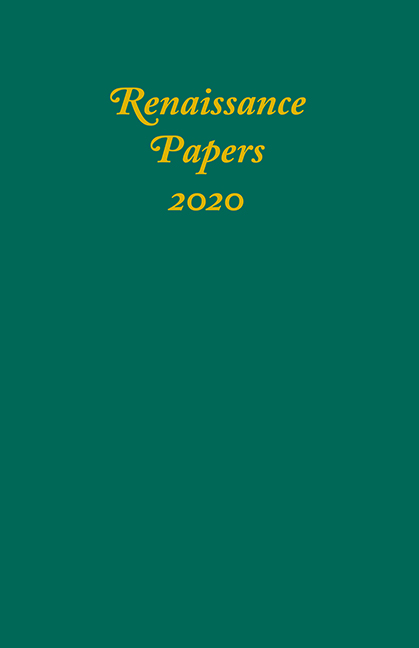Book contents
- Frontmatter
- Contents
- Renaissance Papers
- Post-Marian Piety in Edmund Spenser’s Faerie Queene: The Case of Belphoebe
- Confessions and Obfuscations: Just War and Henry V
- Unfinished Epics: Spenser's Faerie Queene, Shakespeare's Henriad, and the Mystic Plenum
- Translating and Fragmenting Nature in The Divine Weeks
- “The beautifullest Creature living”: Cross-dressing Knights in Mary Wroth's Urania and Margaret Tyler's Mirror of Princely Deeds
- “’Twas I that murder’d thee”: Heartbreak, Murder, and Justice in Early Modern Haunted Lovers’ Ballads
- “Love at First Sight”: The Narrator's Perspective in Marlowe's Hero and Leander
- Recentering the Forest in Early Modern England
- “The house received all ornaments to grace it”: Cavendish, Lanyer, and the Cavalier Ideal of Bonum Vitae
- A Gentleman of Syracuse: Claudio Mario D’Arezzo and Sicilian Nationalism in the Early Modern Mediterranean
- Make Your Mark: Signatures of Queens Regnant in England and Scotland during the 16th Century
Make Your Mark: Signatures of Queens Regnant in England and Scotland during the 16th Century
Published online by Cambridge University Press: 26 May 2022
- Frontmatter
- Contents
- Renaissance Papers
- Post-Marian Piety in Edmund Spenser’s Faerie Queene: The Case of Belphoebe
- Confessions and Obfuscations: Just War and Henry V
- Unfinished Epics: Spenser's Faerie Queene, Shakespeare's Henriad, and the Mystic Plenum
- Translating and Fragmenting Nature in The Divine Weeks
- “The beautifullest Creature living”: Cross-dressing Knights in Mary Wroth's Urania and Margaret Tyler's Mirror of Princely Deeds
- “’Twas I that murder’d thee”: Heartbreak, Murder, and Justice in Early Modern Haunted Lovers’ Ballads
- “Love at First Sight”: The Narrator's Perspective in Marlowe's Hero and Leander
- Recentering the Forest in Early Modern England
- “The house received all ornaments to grace it”: Cavendish, Lanyer, and the Cavalier Ideal of Bonum Vitae
- A Gentleman of Syracuse: Claudio Mario D’Arezzo and Sicilian Nationalism in the Early Modern Mediterranean
- Make Your Mark: Signatures of Queens Regnant in England and Scotland during the 16th Century
Summary
THE signatures of the first three female queens regnant in England and Scotland are an important element of studying their respective queenships. The formal signatures adopted by Mary, Queen of Scots, Mary I of England, and Elizabeth I of England give insight into how these women viewed themselves and how they wished to portray themselves on the public stage.
Sixteenth-century Western Europe saw a curious change in its ruling class: there were more women ruling or governing than there had been before. In Spain, Isabella I (1451–1504) of Castile and her daughter Juana I (1479–1555) of Castile, and later of the Spanish Kingdoms, ruled by their own right. By the middle of the 16th century, England had its first queen regnant in Mary I (1516–58). Scotland’s first queen, Mary Stuart (1542–87), began her reign in 1542. Elizabeth I (1533–1603), who became queen after her elder sister Mary I's short reign, proudly remained unmarried her entire life.
Much has been written about the successes and failures of each of these women, from their marital choices (or lack of) to how they approached the fallout from the Reformation. R. Malcolm Smuts and Melinda J. Gough noted that, “with a few notable exceptions, such as Elizabeth I, queens and other high ranking women have received only limited attention from historians of early modern Europe, and women's contributions to the political and cultural life of the period remain understudied.” The way each of the women contemplated in this paper, including the oft-studied Elizabeth I, presented themselves on both the domestic and the international stage have easily left a mark on political society, because, “the cultural expectations shaping the behavior of each [woman] contributed to the operation of society in which the private business of great … households was inseparable from high politics and statecraft.” In this paper, I seek to understand how each woman sought to represent her public self through the presentation of official signatures.
Prior to 1500, England and Scotland each had a woman who, de facto, was eligible to be queen regnant. The first was Matilda in the 12th century, the only living heir of Henry I.
- Type
- Chapter
- Information
- Renaissance Papers 2020 , pp. 127 - 145Publisher: Boydell & BrewerPrint publication year: 2021

